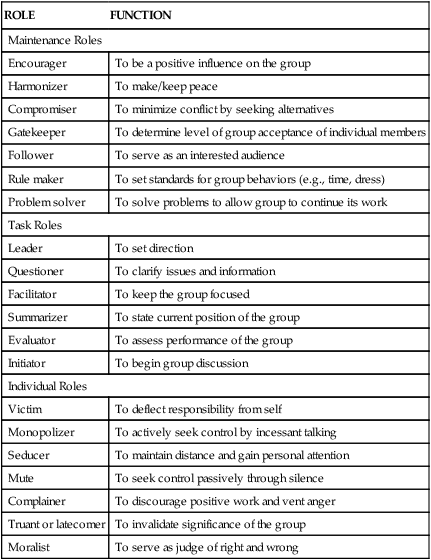2. Describe the components of a small group. 3. Compare the stages of group development. 4. Analyze small-group evaluation factors. 5. Examine the responsibilities and qualities of nurses as group leaders and the types of groups they lead. Groups offer members a variety of relationships as they interact with each other and with the group leader. Because group members come from many backgrounds, they have the opportunity to learn from others outside their usual social circle. They are confronted with envy, anger, aggression, fear, joy, generosity, attraction, competitiveness, and many other emotions and motives expressed by others (Yalom, 2005). All this takes place within the dynamics of the group process in which, with careful leadership, members give and receive feedback about the meaning and effect of their interactions with each other. • Content functions of the group are met when members share their experiences in an effort to help another. They tell their stories, relate their problems, and discuss what they did that worked or did not work to solve those problems. • Process functions allow an individual to receive feedback from other members and the leader about how the member interacts with and is perceived within the group. The group can be viewed as a laboratory in which to observe, experiment, and define relationships and behaviors. Various approaches can be used to increase the therapeutic potential of the group for its members. The components of small groups are summarized in Table 31-1. TABLE 31-1 The following factors influence role selection: the member’s personality, the interaction in the group, and the member’s position in the group. People can play three types of roles in groups (Benne and Sheats, 1948): 1. Maintenance roles, which involve group processes and functions 2. Task roles, which deal with completing the group’s task 3. Individual roles, which are not related to the group’s tasks or maintenance; they may be self-centered and distracting for the group These roles are summarized in Table 31-2. A person who acts as a harmonizer and peacemaker is taking a maintenance role. A person in the task role of questioner may clarify and seek new information. TABLE 31-2
Therapeutic Groups
Overview of Group Therapy
Components of Small Groups
COMPONENT
CHARACTERISTICS
Structure
The group’s underlying order; includes boundaries, communication and decision-making processes, and authority relationships; offers stability and helps regulate behavior and interactional patterns
Size
Preferred size: 7-10 members
Length of sessions
Optimal length of a session: 20-40 minutes for lower-functioning groups and 60-120 minutes for higher-functioning groups (divided into time for a brief warm-up, work time, and a brief wrap-up)
Communication
Feedback used to help members identify group dynamics and communication patterns
Roles
Determined by behavior and responsibilities assumed by the members of the group
Power
Ability to influence the group and other members
Norms
Standards of behavior in the group influence communication and behavior; communicated overtly or covertly
Cohesion
The strength of the members’ desire to work together toward common goals; related to group’s attraction and member satisfaction
Roles
ROLE
FUNCTION
Maintenance Roles
Encourager
To be a positive influence on the group
Harmonizer
To make/keep peace
Compromiser
To minimize conflict by seeking alternatives
Gatekeeper
To determine level of group acceptance of individual members
Follower
To serve as an interested audience
Rule maker
To set standards for group behaviors (e.g., time, dress)
Problem solver
To solve problems to allow group to continue its work
Task Roles
Leader
To set direction
Questioner
To clarify issues and information
Facilitator
To keep the group focused
Summarizer
To state current position of the group
Evaluator
To assess performance of the group
Initiator
To begin group discussion
Individual Roles
Victim
To deflect responsibility from self
Monopolizer
To actively seek control by incessant talking
Seducer
To maintain distance and gain personal attention
Mute
To seek control passively through silence
Complainer
To discourage positive work and vent anger
Truant or latecomer
To invalidate significance of the group
Moralist
To serve as judge of right and wrong

Therapeutic Groups
Get Clinical Tree app for offline access



